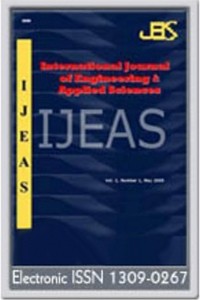New Iterative method to Calculate Base Stress of Footings under Biaxial Bending
Biaxial bending, single footings, base pressures numerical model,
___
- [1] Prakash, S., Saran, S., Bearing capacity of eccentrically loaded footings. Journal of Soil Mechanics & Foundations Div, 1971.
- [2] Gesund, H., Flexural limit design of column footings. Journal of Structural Engineering, 111(11), 2273-2287, 1985.
- [3] Saran, S., Agarwal, R., Bearing capacity of eccentrically obliquely loaded footing. Journal of Geotechnical Engineering, 117(11), 1669-1690, 1991.
- [4] Mahiyar, H., Patel, A., Analysis of angle shaped footing under eccentric loading. Journal of geotechnical and geoenvironmental engineering, 126(12), 1151-1156, 2000.
- [5] Wieneke, K., Kueres, D., Siburg, C., Hegger, J., Investigations on the punching shear behaviour of eccentrically loaded footings. Structural Concrete, 2016.
- [6] Gurfinkel, G., Analysis of footings subjected to biaxial bending. Journal of the Structural Division, 96(6), 1049-1059, 1970.
- [7] Köseoğlu, S., Temeller: statiği ve konstruksiyonu1986; Matbaa Teknisyenleri Basımevi,1986.
- [8] Csenki, A. Foundation Pressures Beneath Rectengular Footings.Proceedings of the Institution of Civil Engineers, 83, 465-473, 1987.
- [9] Özmen, G., Determination of Base Stresses in Rectangular Footings under Biaxial Bending. Teknik Dergi, 22(110), 2011.
- [9] Özmen, G., Determination of Base Stresses in Rectangular Footings under Biaxial Bending. Teknik Dergi, 22(110), 2011.
- [10] Rodriguez-Gutierrez, J., Aristizabal-Ochoa, J.D., Rigid spread footings resting on soil subjected to axial load and biaxial bending. I: Simplified analytical method. International Journal of Geomechanics, 13(2), 109-119, 2012.
- [11] Sarkar, B., Analysis of isolated footing subjected to axial load and high biaxial moments and numerical approach for its solution. The Indian Concrete Journal, 2014(6), 60-80, 2014.
- [12] Guan, Z., Zhang, J., Li, J., A robust computational method for ultimate strength analysis of arbitrary reinforced concrete and composite sections subjected to axial force and biaxial bending. Advances in Structural Engineering, 17(1), 83-96, 2014.
- [13] Smith-Pardo, J.P., Ortiz, A., Blandon, C.A., Biaxial capacity of rigid footings: Simple closed-form equations and experimental results. Engineering Structures, 69, 149-157, 2014.
- [14] Code, T.E., Turkish code for buildings in seismic zones, in Turkish Seismic Code, The Ministry of Public Works and Settlement. 2007: Ankara, Turkey.
- Başlangıç: 2009
- Yayıncı: Akdeniz Üniversitesi
Süleyman Bilgin, Yavuz Üser, Mustafa Oktay
Kadir Mercan, İbrahim Aydoğdu, Ömer Civalek
Gemechis File Duressa, Tesfaye Aga Bullo, Gashu Gadisa Kiltu
